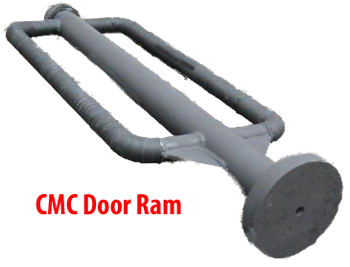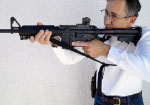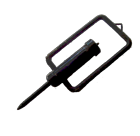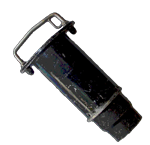Courts recognize that in executing a warrant, officers must, on occasion, damage property in order to perform their duties. The U.S. Supreme Court noted that a reasonable suspicion of exigent circumstances warrants entry by police officers to execute a search warrant, even if forced entry is required, which may result in damages to the premises. (U.S. v. Banks, 540 U.S. 31, 124 S. Ct. 521, 157 L. Ed. 2d 343 (2003))
However, if the amount of damage to a target’s property is excessive or results from malicious intent, constitutional and other claims may arise.
Door breaching is a process used by military, police, or emergency services to force open closed and/or locked doors. The need for forced entry is obvious to anyone with any patrol experience at all. To use a Door Ram effectively, you have to be trained. We all know that getting in the door quickly is paramount to a successful operation. 
A wide range of methods are available, one or more of which may be used in any given situation. The door ram has shown to cause the least amount of damage.
Breaching doors with a CMC Door Ram is not about the biggest strongest guy swinging the ram. Rather it is about properly swinging the ram and letting physics do the work, which is kinetic energy at its best.
You should have the proper weighted ram for the breacher. Although it should be obvious I will repeat here that you can only ram a door that swings in. Most doors on residential homes or apartments open inward. You find outward-opening doors on commercial buildings.
If the door you want to breach opens out you must use a different tool to pry or blow open the door. Most doors we breach will open in so we can use the door ram. The battering or door ram originated in ancient times and was designed to break open the masonry walls of fortifications or splinter their wooden gates.
In its simplest form, a battering or door ram was just a large, heavy log carried by several people and propelled with force against an obstacle; the ram would be sufficient to damage the target if the log was massive enough and/or it were moved quickly enough (that is, if it had enough momentum).
Many battering rams possessed curved or slanted wooden roofs and side-screens covered in protective materials, usually fresh wet hides, presumably skinned from animals eaten by the besiegers. These hide canopies stopped the ram from being set on fire. They also safeguarded the operators of the ram against arrow and spear volleys launched from above. The same thing we do today with shields.
Always protect the breacher with as much ballistic protection as possible. There should always be a point officer to cover the breacher(s). The ram may not penetrate the door but a bullet probably will. (Click here for more history)
When using a Door Ram you must open the door as expediently as possible. To stand in front of the door and keep hitting a lock makes your job more dangerous with every swing. It alerts the suspect to your entry point. If he doesn’t shoot through the door he may prepare a place of advantage for when the entry team comes through the narrow deadly funnel. (Watch a failed breach here)
The Door Ram typically is made with high grade steel and is designed to be cast aside after the breach is made. It is sturdy enough to not damage the ram.
Some ideas for using the Door Ram. Each department needs to establish their own training plans and safety protocols.
- The officer should check the door to see if it is unlocked before using the ram.
- The officer with the ram must bend his knees and look at the exact location of the strike. The strike should be near the locking mechanism.
- He will thrust the ram with as much force as possible and use his legs for more energy and strength.
- At the point of the impact with the door, he will stop the thrust. This technique would be similar to a boxers jab. Important note: The reason you do not follow through with the ram is because the officer could knock the door in and continue the momentum into the house.
- Officers will communicate if the door is open, locked or unlocked to insure that all members of the team are properly informed as to the status of the entry.
- Once the door has been breached, the breacher(s) may follow the entry team into the location.
- Never have your hands on the door side or the front of the ram’s handles.
- Examine the door and frame materials. Some doors are made cheaply, while others are built to last. Take a look at what the door and its frame are made from; the building material will determine the level of force required to breach it.
- Hollow core doors, made of hollow wood or another material that isn't solid, are usually found inside homes between rooms. These doors usually have no insulation or security, and they require minimal force to breach.
- Solid core doors are made from chipped or shaved wood with frames that have laminate on each side. They require a bit more force than hollow core doors.
- Solid wood doors are made of hardwood and require an average amount of force to breach.
- Metal clad doors are made from softwood with a thin metal covering and require an average to above average amount of force.
- Hollow metal doors are much heavier than other doors, have reinforcing channel around the edges and the lock mounting area, and some have insulating material. They require maximum force.
- Figure out which part of the door is weakest. Every door has a weak spot, depending on how it's made. Examine the door to figure out which part is made from the weakest materials. A swift hit will break the weakest part of the door which is usually the frame, the latch, or the lock.
- Is it the frame? If the frame is made from lightweight wood, that may be the weakest part. Even if the lock is heavy duty, you should be able to breach a door with a weak frame.
- Is it the latch or lock? Heavier doors are weakest at the latch, the part of the door that clicks into the frame. They may also be weak just below or above the lock.
- Doorknob Breach
For the doorknob breach, the aim point is a spot halfway between the doorknob and the frame, not at the doorknob itself. This is where you will deliver the blow in order to apply maximum force. If there is not enough room hit the door knob. - Hinge Breach
The hinge breach technique is performed much the same as the doorknob breach, except the breacher aims at the hinges. The first at the middle, then at the top and bottom. Because the hinges are often hidden from view, the hinge breach is more difficult.
Liability for damages is always an issue when we use a door ram. The IACP has a great article on liability when executing a no knock warrant. It applies to all entries. Read it here.





